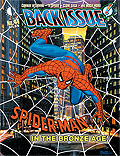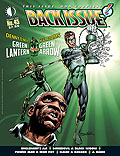 Amazing Spider-Man #96 (May 1971)
Amazing Spider-Man #96 (May 1971)“…and Now, the Goblin!”
Stan Lee/Gil Kane-John Romita
Doug: OK, Faithful Ones, after a few in-betweener posts on the Code and what was going on back in those frightful days of 1968-1971, it’s back to the comics! We kick off our last three posts (whew! Looks like it will be a total of 10 on this topic!) with an examination of Stan Lee’s decision to publish the so-called “drug issues” outside the parameters of the Comics Code Authority, before it was subsequently revised.
Doug: As we go through this, keep in mind that the last post in this series covered The Spectacular Spider-Man #2, published in November 1968 – 2 ½ years before ASM #96 hit the stands. And while we discussed how “psychedelic drugs” were used in the story, there was no conflict with the Code, as that comic was actually a magazine.
 Doug: It’s funny – I got to page 9 of ASM #96, there’d been virtually no web-swinging, and I’d been loving this comic! What characterization! Stan Lee, despite his faults that are brought up in the numerous histories/biographies about him, was a fantastic writer. And let’s compliment the art team of Kane and Romita as well – the pacing of the story was perfect. We’ve discussed Gil Kane under the influence of different inkers in the past – suffice it to say that Jazzy Johnny gets my vote for Number One! Even Kane’s notorious nose up-shots are cured by Romita’s inks. It’s really a nice pairing of talents.
Doug: It’s funny – I got to page 9 of ASM #96, there’d been virtually no web-swinging, and I’d been loving this comic! What characterization! Stan Lee, despite his faults that are brought up in the numerous histories/biographies about him, was a fantastic writer. And let’s compliment the art team of Kane and Romita as well – the pacing of the story was perfect. We’ve discussed Gil Kane under the influence of different inkers in the past – suffice it to say that Jazzy Johnny gets my vote for Number One! Even Kane’s notorious nose up-shots are cured by Romita’s inks. It’s really a nice pairing of talents.Karen: I agree with you about enjoying the story despite the absence of super-heroics early on. I think Spidey’s personal life was always a huge draw for readers. Peter had all the problems the rest of us did, likely more. He was a great Everyman with whom most people could readily sympathize.
Karen: I also enjoyed the art on this issue. My first issue of Spider-Man was #98, which we’ll be getting to shortly. But I was also reading Marvel Tales concurrently, and ever since those days, in my head when I see Spidey it’s always Romita’s version. With him providing the inks on Kane’s work, it was not jarring to go from the reprint to the regular title!
 But what was with that fringed vest Kane drew on Peter? Man, that looks so dated now!
But what was with that fringed vest Kane drew on Peter? Man, that looks so dated now!Doug: Speaking of the aforementioned Spectacular Spider-Man, there is no mention of that story in ASM #96. The only references made to Norman Osborn’s having been the Green Goblin and having at one time known Spider-Man’s secret identity are from a page of flashbacks to ASM #40.
Doug: The first half of the book is about Peter Parker and his various dilemmas: no money, Gwen’s in London but he couldn’t see her because why would Peter and Spidey both be in London, Robbie Robertson may be on to Pete’s secret, Aunt May is trying to be “hep”, etc. It’s pretty standard angst from Stan’s typewriter, but you know what? I love it! I don’t read Spider-Man comics anymore, but I don’t much care for the goings-on I’ve heard about. THIS is my Spider-Man!
 Doug: As the story progresses, Harry sets up an interview for Peter with Harry’s dad Norman. When Pete walks in, he overhears the end of Norman’s physical with a doctor. The doctor stresses to Norman over and over to not exert himself, to not get excited, and to not think about super-heroes or Spider-Man. Of course, you know how this is going to go!
Doug: As the story progresses, Harry sets up an interview for Peter with Harry’s dad Norman. When Pete walks in, he overhears the end of Norman’s physical with a doctor. The doctor stresses to Norman over and over to not exert himself, to not get excited, and to not think about super-heroes or Spider-Man. Of course, you know how this is going to go!Doug: But, the interview goes well, Pete garners a part-time job, and Norman offers to pay Pete’s way to the theatre later that evening where the gang will be watching Mary Jane’s off-Broadway debut. But before heading over, Pete decides to change into his Spidey suit and follow a couple of squad cars that are heading to a call.
 Doug: Spidey comes upon a “stoned” young man wavering atop a highrise roof. The guy keeps mumbling how he can fly, he’s a lion, he’s an eagle, and then he loses what little balance he has and plummets toward the ground. Fortunately Spidey swoops down on a webline and saves the guy.
Doug: Spidey comes upon a “stoned” young man wavering atop a highrise roof. The guy keeps mumbling how he can fly, he’s a lion, he’s an eagle, and then he loses what little balance he has and plummets toward the ground. Fortunately Spidey swoops down on a webline and saves the guy. Karen: Even though Stan himself has admitted he did no research for this story (or any other, from what he says), the incident with the freaked out kid on the roof plays very seriously, even when Peter makes a little speech afterwards about the evils of drugs. I don’t know what sort of drug Stan thought would cause that kid to go up on a roof like that, but the fall could really be seen as a metaphor for the damage drugs can do to one’s life.

 Doug: Once Pete gets to the theatre, housed in a building formerly owned by Norman Osborn, he groups up with Harry and MJ, as well as Norman. The group is waiting on Randy Robertson, who arrives shortly and gets really militant about the drug issues in society and how it’s not a “black” problem – it’s everyone’s problem. Then he gets up in Osborn’s grill about being a white rich guy, and why doesn’t he do something with his money and influence? Not good, as this begins to set Osborn off…
Doug: Once Pete gets to the theatre, housed in a building formerly owned by Norman Osborn, he groups up with Harry and MJ, as well as Norman. The group is waiting on Randy Robertson, who arrives shortly and gets really militant about the drug issues in society and how it’s not a “black” problem – it’s everyone’s problem. Then he gets up in Osborn’s grill about being a white rich guy, and why doesn’t he do something with his money and influence? Not good, as this begins to set Osborn off…Karen: More social commentary from Stan, which might seem hokey now, but I’m sure it was surprising back then. I have always been impressed with the way Stan and the Bullpen made sure to work black characters into stories. When you open a Marvel comic from this era, you’ll see not only black supporting characters like Randy and Joe Robertson, but backgrounds with black cab drivers, policemen, firemen, etc. There was a real effort on Marvel’s part to show society in all its facets. With Randy, we see his frustration, but he doesn’t come across as a one-dimensional “angry young black man”.
 Karen: This issue is also a harsh reminder of what Mary Jane was like in the early days: a flirt, even manipulative. She deliberately gloms on to Peter, apparently just to upset Harry. This was not the girl Peter was supposed to marry, at least not originally!
Karen: This issue is also a harsh reminder of what Mary Jane was like in the early days: a flirt, even manipulative. She deliberately gloms on to Peter, apparently just to upset Harry. This was not the girl Peter was supposed to marry, at least not originally!  Doug: While in the theatre, the group meets backstage during intermission to congratulate MJ on what has thus far been a great show. But, Pete notices that Norman is sweating and uncomfortable. Pete also notices that Norman is standing close to an unmarked door, and then his Spider-sense begins to tingle. Could this be one of the Goblin’s secret hide-outs?
Doug: While in the theatre, the group meets backstage during intermission to congratulate MJ on what has thus far been a great show. But, Pete notices that Norman is sweating and uncomfortable. Pete also notices that Norman is standing close to an unmarked door, and then his Spider-sense begins to tingle. Could this be one of the Goblin’s secret hide-outs?Doug: After the show is over and everyone’s saluted MJ’s efforts, Norman and Peter find excuses to head their separate ways. You can see where this is headed, and it ain’t good!



















































6 comments:
The fact that the two SPECTACULAR SPIDER-MAN stories were not actually in continuity was driven home a bit later when issue one was reprinted (with extensive changes!) in the regular Spidey title. This was very confusing to those of us paying attention as the story of Richard Raleigh had strangely already been tied to DAREDEVIL several years earlier at that point as I recall! Issue two, one of my favorite Spider-Man stories, was just never mentioned again as far as I know.
Frustrating, wasn't it, Steve?
We've all known stories of Stan's poor memory, but to think that he'd written a MAJOR Green Goblin story only a few years before our story-at-hand and chose to ignore it is very strange. And you'll see as we get to the next review in the series, of ASM 97, how incredulous I was that Stan used some of the same plot devices with no mention of Spidey thinking to himself, "Well, let's try this again, because it worked for me last time!".
But like you also said, all of this doesn't take away from the fact that Spectacular Spider-Man #2 contained a great story, with Johnny Romita at the very top of his game -- perhaps never a better job on his part on any other Spider-Man story.
Thanks for the comments!!
I absolutely loved the drug issues. In fact, that whole period from about 50-150 is just so good it blows my mind. I really like watching MJ turn from the shallow, manipulative flirt into a more adult woman. One of my favorite moments in all of comics is the look on MJ's face at the end of the whole "Death of Gwen" story as she almost leaves, then doubles back to be with Pete. Just gives me chills.
True, Chris -- a very poignant scene. Karen (and others) have remarked that over the passage of time, MJ took on many of Gwen's characteristics. She became more likeable as the years passed.
Karen takes MJ to task in our upcoming two posts that conclude the Revised Code series, however!
Hey, I won't argue that, initially, she was a royal pain in the hiney. Flighty as all get out and shallow as they come. But I'm okay with her becoming more Gwen-like, in that in this case Gwen-like means mature, responsible adult.
I maintain that the problem with MJ's character wasn't that she married Pete, it's that the 90's happened and she just froze. No movement at all, plus occasional highly annoying bouts of returned shallowness. Once you hit Maximum Carnage, it's just a constant cycle of "Stop being Spider-Man, It's okay your Spider-Man, Stop, Okay, Stop, Okay" until you want to scream. Then they kill her off, bring her back but separate them, and then JMS finally makes her interesting again.
Then One More Day happened. Sigh.
Wouldn't you say 39-150 instead of 50-150?
Post a Comment